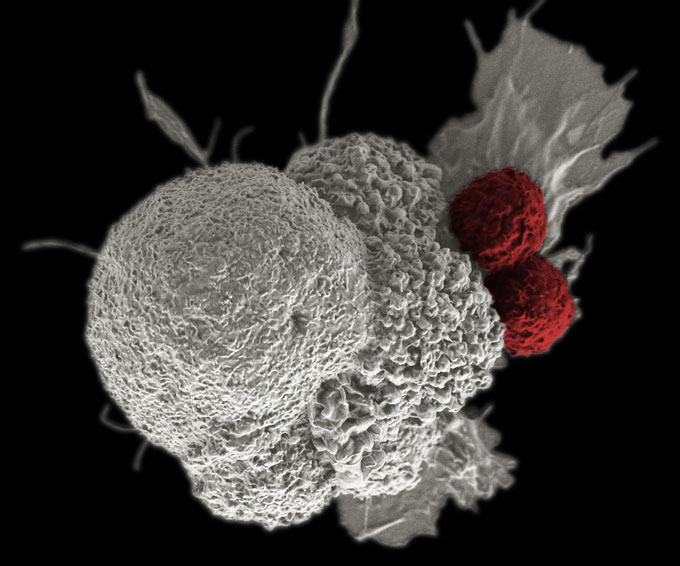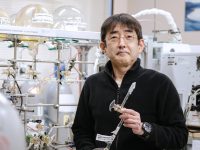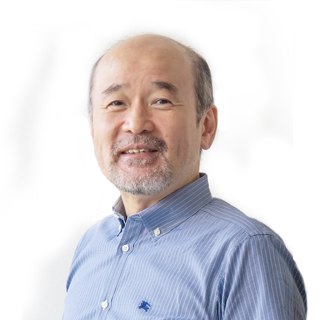Researchers unravel the mechanisms of Epstein-Barr virus (EBV) and host chromatin interactions in nasopharyngeal cancer cells
Nasopharyngeal cancer (NPC) is a rare cancer of the nasopharynx and is associated with an accompanying Epstein-Barr virus (EBV) infection. EBV is known to alter the host genome and activate latent genes promoting tumor formation. However, EBV-host epigenomic interactions and alterations in NPC are not well understood. In a recent study, researchers from Japan and Singapore revealed that EBV hijacked host enhancers to rewire the host genome and dysregulate gene expression, thus promoting NPC progression.

Image title: Researchers elucidate the cross-species genomic interactions between Epstein-Barr virus (EBV) and host cells.
Image caption: EBV interacts at specific locations within the B compartment of the host chromatin structure and hijacks gene enhancers. The activation of enhancers activates the expression of PLA2G4A, PTGS2, and CITED2, which leads to uncontrolled cell proliferation.
Image credit: “Cancer Immunotherapy” by National Institutes of Health (NIH) on Openverse
https://openverse.org/image/6cb65b79-cbdc-4198-b3f4-30a65dcffd25
Image license: CC BY-NC 2.0
Nasopharyngeal carcinoma (or NPC) is a rare type of cancer affecting the epithelial tissue of the nasopharynx, the upper part of the throat behind the nasal cavity. Among the three main subtypes of NPC, non-keratinizing undifferentiated squamous carcinoma is endemic to the regions of Southern China and Southeast Asia, with a strong association with Epstein-Barr virus (or EBV) infection. EBV, also known as human tumor virus, is a double-stranded DNA virus that is associated with various cancers, such as Burkitt lymphoma, T-cell lymphoma, and gastric cancer. EBV genomes mostly survive autonomously as episomes or extrachromosomal DNA (ecDNA) by attaching to the host chromosome in the nucleus. Most of the EBV genome is repressed by methylation of their DNA and thus expresses limited genes. However, once EBV infects a host, it targets the host heterochromatin (a condensed form of DNA) and activates many latent host and viral genes that promote tumor formation. ‘Enhancer infestation’ or the activation of repressed enhancers (DNA-regulatory elements that activate transcription of a gene or genes) in the host genome, is one of the many ways of host genome rewiring by EBV. Although EBV-host cell interactions have been studied in many EBV-associated cancers, the cross-species genomic interaction and consequent chromatin changes in NPC have not been demonstrated.
In a recent study published in Volume 102 of eBioMedicine on March 14, 2024, Professor Atsushi Kaneda from the Graduate School of Medicine, Chiba University, Japan, and Associate Professor Melissa Jane Fullwood from the School of Biological Sciences, Nanyang Technological University, Singapore (NTU Singapore), have attempted to fill this knowledge gap by conducting collaborative research with their colleagues and scientists from Kanazawa University and Hamamatsu University School of Medicine, Japan, and from Duke-NUS Medical School, Singapore.
Explaining the motivation behind this study, an enthusiastic Assoc Prof Fullwood explains, “I thought it would be very helpful if we could clarify the molecular mechanisms of cancer development and establish novel therapeutic strategies targeting not only resectable cancers but also intractable, metastatic, or recurrent cancers.”
To undertake this examination, Dr. Harue Mizokami and colleagues conducted Hi-C, 4C-seq, CHIP-seq, and RNA-seq analyses to thoroughly understand the epigenomic rewiring and genetic dysregulation using C666-1 EBV (+)-NPC cell lines, NP69T immortalized nasopharyngeal epithelial cells, clinical NPC biopsy samples, and in vitro EBV infection in human EBV (-) cell lines HK1 and NPC-TW01.
In C666-1, it was observed that EBV genomes interacted with the host genome primarily in AT-rich, gene-poor regions, called the EBV-interacting regions or EBVIRs, that were located within the inactive B compartment of the host heterochromatin. Furthermore, using Hi-C and CHIP-seq, they found that the EBV ecDNA may relax the inactive B compartments by activating enhancers in NPC cells. Moreover, the identified EBVIRs displayed significantly higher levels of histone protein alterations compared to NP69T, confirming genome restructuring. The above findings were also validated in clinical NPC biopsy samples.
Moreover, aberrant enhancer activation or genome rewiring resulted in dysregulated gene expression. Hi-C analysis identified H3K4me3(+) as one of the main genes affected by the EBV-host epigenomic alterations. Confirming the above finding, RNA-seq analysis of NP69T and C666-1 cells found increased expression of 14 H3K4me3(+) genes in C666-1. EBVIRs altered the expressions of the target genes PLA2G4A,PTGS2, and CITED2 in NPC cells.Their upregulation contributed to the growth of cancer cells, while the knockdown of these genes showed a significant reduction of NPC cell growth.
Discussing the impact of these findings, a hopeful Prof. Kaneda surmises, “Our findings will generate interest and create awareness among people on the ability of a virus to epigenetically alter our body’s cells and cause diseases such as cancer. Moreover, the elucidated epigenetic mechanisms of cancer development will enable the development of novel cancer therapeutic strategies other than genome target therapy.”
In summary, the study provides important insights into the mechanisms of virus-mediated tumorigenesis and paves the way for the development of novel therapeutic strategies.
About Professor Atsushi Kaneda
Dr. Atsushi Kaneda is a Professor at the Department of Molecular Oncology, Graduate School of Medicine at Chiba University, Japan. He is also the Director of Health and Disease Omics Center at Chiba University. He has conducted the JST CREST project, and undertaken AMED cancer projects to clarify epigenomic alteration and tumorigenesis by environmental factors. Professor Kaneda’s work focuses on epigenomic modifications and genetic aberrations that cause cancer. He has more than 230 publications to his credit.
About Associate Professor Melissa Jane Fullwood
Dr. Melissa Jane Fullwood is an Associate Professor in the School of Biological Sciences, Nanyang Technological University. Assoc Prof Fullwood’s work focuses on the 3D genome organization of DNA and RNA in cancer and Artificial Intelligence for investigating epigenomics and transcriptomics. She has conducted projects under the National Research Foundation (NRF) Fellowship, as well as received grants from AISG, Ministry of Education, and the National Medical Research Council. She has also participated in projects under the NRF CRP program. She has published 55 publications which have been cited more than 19,000 times.
Funding:
This study was supported by grants from the Japan Agency for Medical Research and Development (19ck0106263h0003 and 22zf0127008s0301), Japan Society for the Promotion of Science (20K18271, 22K19553, and JPJSCCA20200006), the Singapore Ministry of Health’s National Medical Research Council under its Singapore Translational Research Investigator Award STaR (MOH-000709), the Ministry of Education, Singapore, under its Academic Research Fund Tier 1 (RG86/21), Global and Prominent Research 2018-Y9 and IAAR Research Support Program from Chiba University.
Reference:
Title of original paper: Enhancer infestation drives tumorigenic activation of inactive B compartment in Epstein-Barr virus-positive nasopharyngeal carcinoma
Authors:
Harue Mizokami1,2, Atsushi Okabe1,3, Ruchi Choudhary4, Masato Mima1,5, Kenta Saeda1,6, Masaki Fukuyo1, Bahityar Rahmutulla1, Motoaki Seki1, Boon-Cher Goh7,8,9, Satoru Kondo2, Hirotomo Dochi2, Makiko Moriyama-Kita2, Kiyoshi Misawa5, Toyoyuki Hanazawa6, Patrick Tan10, Tomokazu Yoshizaki2, Melissa Jane Fullwood4,11,12, Atsushi Kaneda1,3
Affiliations:
- Department of Molecular Oncology, Graduate School of Medicine, Chiba University, Chiba 260-8670, Japan
- Division of Otolaryngology and Head and Neck Surgery, Graduate School of Medical Science, Kanazawa University, Kanazawa, Ishikawa 920-8640, Japan
- Health and Disease Omics Center, Chiba University, Chiba 260-8670, Japan
- School of Biological Sciences, Nanyang Technological University, 60 Nanyang Drive, Singapore 637551, Singapore
- Department of Otorhinolaryngology/Head and Neck Surgery, Graduate School of Medicine, Hamamatsu University School of Medicine, Shizuoka 431-3125, Japan
- Department of Otorhinolaryngology / Head and Neck Surgery, Graduate School of Medicine, Chiba University, Chiba 260-8670, Japan
- Cancer Science Institute of Singapore, National University of Singapore, 14 Medical Drive, Singapore 117599, Singapore
- Department of Haematology-Oncology, National University Cancer Institute, Singapore, 5 Lower Kent Ridge Road, Singapore 119074, Singapore
- Department of Pharmacology, Yong Loo Lin School of Medicine, National University of Singapore, Blk MD3, 16 Medical Drive, Singapore 117600, Singapore
- Cancer and Stem Cell Biology Program, Duke-NUS Medical School, Singapore 169857, Singapore
- Cancer Science Institute of Singapore, Centre for Translational Medicine, National University of Singapore, Singapore 117599, Singapore
- Institute of Molecular and Cell Biology, Agency for Science, Technology and Research (A*STAR), 61 Biopolis Drive, Proteos, Singapore 138673, Singapore
Journal: eBioMedicine
DOI: https://doi.org/10.1016/j.ebiom.2024.105057
Contact:
Public Relations Office, Chiba University
Address: 1-33 Yayoi, Inage, Chiba 263-8522 JAPAN
Email: koho-press@chiba-u.jp
Tel: +81-43-290-2018
Medical, Pharmaceutical and Health Administration Department
General Affairs Division, Kanazawa University
Address: 13-1 Takaramachi, Kanazawashi, Ishikawa 920-8640 JAPAN
Email: t-isomu@adm.kanazawa-u.ac.jp
Public Relations Office, Hamamatsu University School of Medicine
Address: 1-20-1 Handayama, Chuo-ku, Hamamatsu city, Shizuoka 431-3192
Email: koho@hama-med.ac.jp
Recommend
-

The joy of revealing the unknown: The challenge of solving the mystery of the Sun
2022.09.28
-

Harnessing CO2 with a Photocatalyst for Fuel and Plastic Feedstocks: Advancing a Sustainable Society with Chemistry
2023.06.22
-

Live on the Moon, Settle on Mars: Research Center for Space Agriculture and Horticulture for Space Food Production and Supply
2023.10.20


